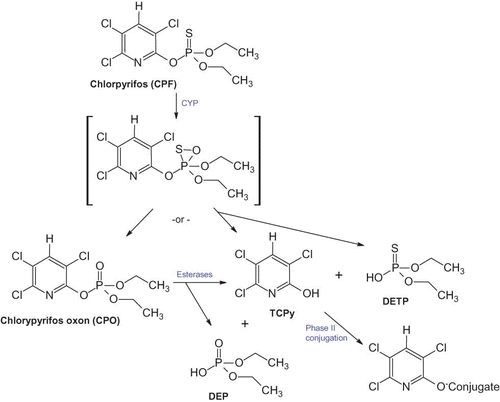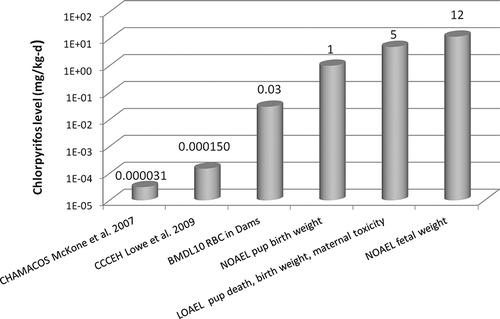Figures & data
FIGURE 1. Major metabolic pathways of chlorpyrifos metabolism. CPF is metabolized by cytochrome P-450 (CYP). CPO is the primary toxic metabolite and is detoxified by esterases including carboxylases and paraoxonase (PON1) (color figure available online).

TABLE 1. Biomarkers of Organophosphate Exposures and Their Relevance to Chlorpyrifos
TABLE 2. Characteristics of the Epidemiologic Studies Reporting Associations Between Chlorpyrifos or Relevant Metabolites and Fetal Growth Outcomes
TABLE 3. Summary of growth indices by metabolite
TABLE 4. Summary of PON1 results presented by the Mt. Sinai Cohort that are related to potential CPF biomarker exposure
TABLE 5. Birth outcomes and other related measures in animal CPF studies
FIGURE 2. Comparison of NOAELs and LOAELs for fetal weight, birth weight, and maternal toxicity from animal studies with human exposure estimates. Human exposure estimates were calculated from McCone et al. (2007) based on CHAMACOS study. CitationMcKone et al. (2007) estimated total CPF exposures (dietary, inhalation, dermal, nondietary ingestion) among pregnant women in the CHAMACOS cohort to be 1.43 to 6.73 nmol/d, which is equivalent to 0.007 to 0.031μg/kg-d, assuming a 75.8-kg pregnant female (CitationU.S. EPA 2011a, from NHANES). CitationLowe et al. (2009) estimated exposures based on umbilical cord blood levels from the CCCEH cohort (CitationWhyatt et al. 2005). The NOAEL of 1 mg/kg-d for pup birth weight is based on non-statistically significant treatment-related decreases at 5 mg/kg-d CitationBreslin et al. (2006) and CitationMaurissen et al. (2000) (see ). The LOAEL of 5 mg/kg-d for maternal toxicity (e.g., tremors) and pup death is based on CitationMaurissen et al. (2000). The NOAEL of 12 mg/kg-d for fetal birth weight is the highest NOAEL for effects in multiple studies as summarized in .
